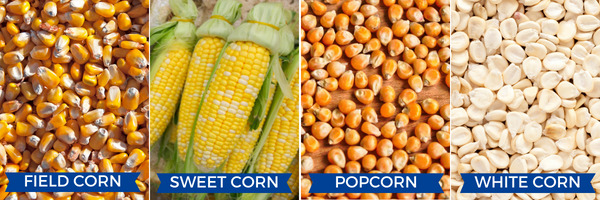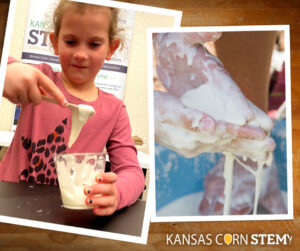Two Corn-Tastic Activities for Spring Break!
Did you know there are over 3,500 uses for corn? Many are in products that we use every day. But not all corn is the same, different types of corn have different traits that make them better for intended uses.

- Field corn (dent corn) is the most common corn grown in Kansas. It has a high starch content, which makes it perfect for livestock feed and ethanol fuel. It is also used to make sweeteners and corn starch for many uses. Almost all of the corn grown in Kansas is field corn.
- Sweet corn is what is grown for canned corn or corn on the cob. It is harvested earlier than the other types so it still has “the juice. Because it is picked before the ear matures, this corn is sweet because the sugars haven’t converted to starch.!
- Popcorn is a variety developed specifically to pop when heated. Why does it pop? A kernel of popcorn contains a small amount of water stored inside a circle of soft starch, surrounded by the kernel’s hard outer surface. As the kernel heats up, the water expands, building pressure. Eventually, the hard outer layer gives way, causing the popcorn kernel to explode. As it explodes, the soft starch inside the popcorn inflates and bursts, turning the kernel inside out.
- White and yellow food grade corn varieties are used to make tortillas, chips, corn meal, corn starch and many other products.
Activity 1: Learn How is Field Corn is Grown
Read the book, “We Grow Corn! Raising Corn on a Kansas Family Farm” online at wegrowcorn.com to learn more about how field corn is raised on a farm. Then follow the corn after it is harvested with this coloring page!
Did you know? From the molding process to helping keep the paper labels in place, corn products are involved in almost every step of making crayons. Corn starch, which you’ll learn about below, is often used to coat molds for many items like legos or crayons to make it easy to get out, just like when you grease a cake pan.
 Activity 2: Oobleck, the Corn-Based Slime
Activity 2: Oobleck, the Corn-Based Slime
Read the classic, “Bartholomew and the Oobleck” by Dr. Suess and make some Oobleck of your own! Don’t have a copy of the book at home? No problem! Listen to the book read aloud here.
The main ingredient in Oobleck is corn starch. Corn starch is a powder that comes from the starchy long sugars, known as carbohydrates, found in a corn kernel. When corn starch and water are mixed in the right proportions, they create a substance called Oobleck, named after the book by Dr. Seuss titled, Bartholomew and the Oobleck. This crazy substance is both a liquid and a solid. The Oobleck will feel like a solid if you tap it, but if you dip your hand slowly into the mix, your fingers will slide through like it is a liquid.
Oobleck can be a little messy, Be sure to lay down some newspapers or plastic sheets to make clean-up easier. You can also add non-staining food dye to add some color!
Instructions:
- Fill a cup with 4 level tablespoons of corn starch.
- Add 2 tablespoons of water.
- Mix together with a popsicle stick or spoon.
- You want a batter-like consistency that easily flows when slowly stirred but heavily thickens when quickly stirred or when a force is applied to it.
- Adjust with a tiny bit more cornstarch if too runny or a tiny bit more water if it’s too thick and powdery.
- Play with it!
An instruction video at wegrowcorn.com can be used to guide you through the activity.
What to do with Oobleck:
- Stir it fast, stir it slow.
- Pour it into your hands. Form it, roll it, play with it; then stop and try to hold it in your hands.
- Toss it in the air and then catch it. Toss it back and forth with a parent or friend.
- Toss it in the air and let it hit the ground.
- Use your imagination to find other ways to play with Oobleck!
Fun Fact! Oobleck is a non-Newtonian fluid because it doesn’t follow Newton’s laws of viscosity. Water surrounds the starch molecules which allow them to slowly move freely, making it a liquid. But when moved too fast the water gets pushed out and the starch molecules collide with each other, forming a solid. Then when stopped, the water molecules move back in between the starch molecules to return to a liquid.
Cleanup: Oobleck can be messy, but it is easy to clean up. Wash hands with water. Pour the Oobleck on a plastic bag and dispose of it in the trash. Wipe up any dried cornstarch with a dry cloth before cleaning up any remaining residue with a damp sponge.
This activity is adapted from Kansas Corn STEM’s We Grow Corn Library Series. Encourage your local public library to check it out at kansascornstem.com and order their own series kit today. This kit is currently only available for Kansas public libraries, however we also offer lessons, kits and other resources for Kansas teachers grades PreK-12 as well as home school educators.
